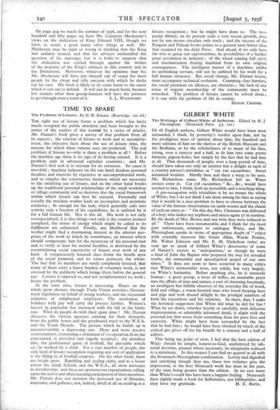MANY WORDS
Tufts book is a tiresome and rambling attempt at a biographical study. It fills 584 pages ; at least two-thirds of them are irrelevant to the subject. There is no index (and, for that matter, no table of contents), though the lack of one hardly matters, still no reader is likely to consult the book for any serious purpose. The style is curiously demo& ; two examples, taken from a page chosen at random, may suffice as illustrations : " On August 9th, 1931, the Old Lady of Threadneedle Street flung herself on her back in the traditional style of hysterical matrons, drummed with her legs on the pavement, and howled for Mr. Ramsay MacDonald to come down from Lossiemouth and restore hcr."
And five lines lower down : " It was even suggested, though of course not in so many words, that the Old Lady of Threadneedle Street had been carrying on with Mr. Baldwin and Sir Herbert Samuel—as well as Mr. MacDonald -- and that as a result she bore in her womb the embryo of a three- headed bulldog whose name—National Government—had already been chosen."
The first hundred pages are an unsystematic and haphazard record of events between 1894 and 1912. The first page of the first chapter is a good specimen of this record. Paragraph one gives an account of the birth of a son to the Duke and Duchess of York. Paragraph two describes Mr. Compton Mackenzie's reflections as a schoolboy—on this particular day—in Richmond Park. Paragraph three begins : " The afternoon of that auspicious day was saddened by an explosion at the Albion Colliery near Pontypridd." On page tot we are not yet out of the wood. The Prince of Wales matriculates at Magdalen, and we have a long excursus on Magdalen as the author knew it. Then follows a chapter on royalty in the War, with the usual excursuses—one of them on monarchy in Greece and the deposition of King Constantine. So the book continues until, suddenly, there is a break ; pages 234-347 deal at length with the marriages and mistresses of the House of Hanover. It is difficult to understand why such a digression is made at this st age of the book, and why it is necessary to intro- duce so much detail about the four Georges. The reader is in- clined to remember an answer of Queen Victoria to one of Lord John Russell's many constitutional lectures to his sovereign : " The Queen cannot make out what the doctrines of the Revolution of 1688 have to do with this." Mr. Compton Mackenzie's account of the scandalous lives of the sons of George III is followed by another disquisition of some sixty pages on " The Church of England and Marriage." Mr. Mackenzie's manner of conducting a controversy on a com- plicated question of ecclesiastical law may be seen from the concluding words of his chapter. He is discussing the signifi- cance of the Archbishop of Canterbury's broadcast of December t3th, 1936. He gives two possible interpretations ; the second is, simply, that " as some might put it . . . founded upon one divorce, the Church of England has now been triumphantly refounded upon another." On page 404 we reach the summer of 1936, and for the next hundred and fifty pages we have Mr. Compton Mackenzie's views on the abdication of King Edward VIII, though we have, as usual, a great many other things as well. Mr. Mackenzie may be right or wrong in thinking that the King was unfairly treated, and that his advisers mishandled the question of his marriage, but it is futile to suppose that the abdication was carried through against the wishes of the majority of the King's subjects in this country and in the Dominions. Moreover, whatever his opinions may be, Mr. Mackenzie will have put himself out of count for most people by the cheap and silly sarcasm with which he decks out his case. His book is likely to do some harm to the cause which it sets out to defend. It will not do much harm, because few readers other than gossip-hunters will have the patience



































 Previous page
Previous page